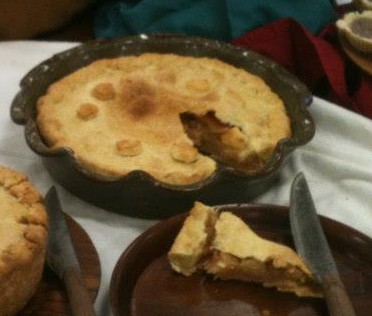Introduction:
The final dish of the first course of the Taming of the Shrew event – the menus called for buttery cakes, but I wanted a carb in this course that could be eaten by all guests, including vegans. One of the richest vegan breads I could think of was foccacia – and conviently, while Scappi doesn’t provide a recipe for it, he does mention it in recipe 142, book VI of the Opera.
Discussion
- According to Fiorenzo Toso, modern linguist and author of the “Little Ligurian Dictionary”, the word fugassa (a term in the Genoese dialect of fogaccia) appears for the first time in a document written in 1300, so this type of bread had a history in northern Italy well before Scappi’s career. (
- The defining feature of foccacia is the heavy inclusion of olive oil, both in the dough and as a topping (along with other flavorings, in this case salt but in others garlic, rosemary and other herbs, or even rendered pork cracklings). It’s also a high-hydration dough, which is improved by reducing the yeast and allowing a longer, slower rise time, if possible.
Sources:
1302597
{1302597:CTQP5R9M},{1302597:WEGAZA6D}
1
modern-language-association
50
default
1431
https://www.erminespot.com/wp-content/plugins/zotpress/
%7B%22status%22%3A%22success%22%2C%22updateneeded%22%3Afalse%2C%22instance%22%3Afalse%2C%22meta%22%3A%7B%22request_last%22%3A0%2C%22request_next%22%3A0%2C%22used_cache%22%3Atrue%7D%2C%22data%22%3A%5B%7B%22key%22%3A%22WEGAZA6D%22%2C%22library%22%3A%7B%22id%22%3A1302597%7D%2C%22meta%22%3A%7B%22creatorSummary%22%3A%22Davidson%20and%20Jaine%22%2C%22parsedDate%22%3A%222006%22%2C%22numChildren%22%3A1%7D%2C%22bib%22%3A%22%3Cdiv%20class%3D%5C%22csl-bib-body%5C%22%20style%3D%5C%22line-height%3A%202%3B%20padding-left%3A%201em%3B%20text-indent%3A-1em%3B%5C%22%3E%5Cn%20%20%3Cdiv%20class%3D%5C%22csl-entry%5C%22%3EDavidson%2C%20Alan%2C%20and%20Tom%20Jaine.%20%3Ci%3EThe%20Oxford%20Companion%20to%20Food%3C%5C%2Fi%3E.%202nd%20ed%2C%20Oxford%20University%20Press%2C%202006.%3C%5C%2Fdiv%3E%5Cn%3C%5C%2Fdiv%3E%22%2C%22data%22%3A%7B%22itemType%22%3A%22book%22%2C%22title%22%3A%22The%20Oxford%20companion%20to%20food%22%2C%22creators%22%3A%5B%7B%22creatorType%22%3A%22author%22%2C%22firstName%22%3A%22Alan%22%2C%22lastName%22%3A%22Davidson%22%7D%2C%7B%22creatorType%22%3A%22author%22%2C%22firstName%22%3A%22Tom%22%2C%22lastName%22%3A%22Jaine%22%7D%5D%2C%22abstractNote%22%3A%22%22%2C%22date%22%3A%222006%22%2C%22language%22%3A%22%22%2C%22ISBN%22%3A%229780192806819%22%2C%22url%22%3A%22%22%2C%22collections%22%3A%5B%2236TMQHXD%22%2C%22WDUWUYUL%22%5D%2C%22dateModified%22%3A%222024-06-08T14%3A35%3A37Z%22%7D%7D%2C%7B%22key%22%3A%22CTQP5R9M%22%2C%22library%22%3A%7B%22id%22%3A1302597%7D%2C%22meta%22%3A%7B%22creatorSummary%22%3A%22Scappi%20and%20Scully%22%2C%22parsedDate%22%3A%222008-12-15%22%2C%22numChildren%22%3A1%7D%2C%22bib%22%3A%22%3Cdiv%20class%3D%5C%22csl-bib-body%5C%22%20style%3D%5C%22line-height%3A%202%3B%20padding-left%3A%201em%3B%20text-indent%3A-1em%3B%5C%22%3E%5Cn%20%20%3Cdiv%20class%3D%5C%22csl-entry%5C%22%3EScappi%2C%20Bartolomeo%2C%20and%20Terence%20Scully.%20%3Ci%3EThe%20Opera%20of%20Bartolomeo%20Scappi%20%281570%29%3A%20L%26%23x2019%3BArte%20Et%20Prudenza%20D%26%23x2019%3BUn%20Maestro%20Cuoco%3C%5C%2Fi%3E.%20University%20of%20Toronto%20Press%2C%202008.%3C%5C%2Fdiv%3E%5Cn%3C%5C%2Fdiv%3E%22%2C%22data%22%3A%7B%22itemType%22%3A%22book%22%2C%22title%22%3A%22The%20Opera%20of%20Bartolomeo%20Scappi%20%281570%29%3A%20L%27Arte%20Et%20Prudenza%20D%27Un%20Maestro%20Cuoco%22%2C%22creators%22%3A%5B%7B%22creatorType%22%3A%22author%22%2C%22firstName%22%3A%22Bartolomeo%22%2C%22lastName%22%3A%22Scappi%22%7D%2C%7B%22creatorType%22%3A%22author%22%2C%22firstName%22%3A%22Terence%22%2C%22lastName%22%3A%22Scully%22%7D%5D%2C%22abstractNote%22%3A%22Bartolomeo%20Scappi%20%28c.%201500-1577%29%20was%20arguably%20the%20most%20famous%20chef%20of%20the%20Italian%20Renaissance.%20He%20oversaw%20the%20preparation%20of%20meals%20for%20several%20Cardinals%20and%20was%20such%20a%20master%20of%20his%20profession%20that%20he%20became%20the%20personal%20cook%20for%20two%20Popes.%20At%20the%20culmination%20of%20his%20prolific%20career%20he%20compiled%20the%20largest%20cookery%20treatise%20of%20the%20period%20to%20instruct%20an%20apprentice%20on%20the%20full%20craft%20of%20fine%20cuisine%2C%20its%20methods%2C%20ingredients%2C%20and%20recipes.%20Accompanying%20his%20book%20was%20a%20set%20of%20unique%20and%20precious%20engravings%20that%20show%20the%20ideal%20kitchen%20of%20his%20day%2C%20its%20operations%20and%20myriad%20utensils%2C%20and%20are%20exquisitely%20reproduced%20in%20this%20volume.Scappi%27s%20Opera%20presents%20more%20than%20one%20thousand%20recipes%20along%20with%20menus%20that%20comprise%20up%20to%20a%20hundred%20dishes%2C%20while%20also%20commenting%20on%20a%20cook%27s%20responsibilities.%20Scappi%20also%20included%20a%20fascinating%20account%20of%20a%20pope%27s%20funeral%20and%20the%20complex%20procedures%20for%20feeding%20the%20cardinals%20during%20the%20ensuing%20conclave.%20His%20recipes%20inherit%20medieval%20culinary%20customs%2C%20but%20also%20anticipate%20modern%20Italian%20cookery%20with%20a%20segment%20of%20230%20recipes%20for%20pastry%20of%20plain%20and%20flaky%20dough%20%28torte%2C%20ciambelle%2C%20pastizzi%2C%20crostate%29%20and%20pasta%20%28tortellini%2C%20tagliatelli%2C%20struffoli%2C%20ravioli%2C%20pizza%29.Terence%20Scully%20presents%20the%20first%20English%20translation%20of%20the%20work.%20His%20aim%20is%20to%20make%20the%20recipes%20and%20the%20broad%20experience%20of%20this%20sophisticated%20papal%20cook%20accessible%20to%20a%20modern%20English%20audience%20interested%20in%20the%20culinary%20expertise%20and%20gastronomic%20refinement%20within%20the%20most%20civilized%20niche%20of%20Renaissance%20society.%22%2C%22date%22%3A%222008-12-15%22%2C%22language%22%3A%22en%22%2C%22ISBN%22%3A%229780802096241%22%2C%22url%22%3A%22%22%2C%22collections%22%3A%5B%2236TMQHXD%22%2C%22UJBYGZAI%22%5D%2C%22dateModified%22%3A%222013-02-17T16%3A46%3A33Z%22%7D%7D%5D%7D
Davidson, Alan, and Tom Jaine. The Oxford Companion to Food. 2nd ed, Oxford University Press, 2006.
Scappi, Bartolomeo, and Terence Scully. The Opera of Bartolomeo Scappi (1570): L’Arte Et Prudenza D’Un Maestro Cuoco. University of Toronto Press, 2008.

One Comment